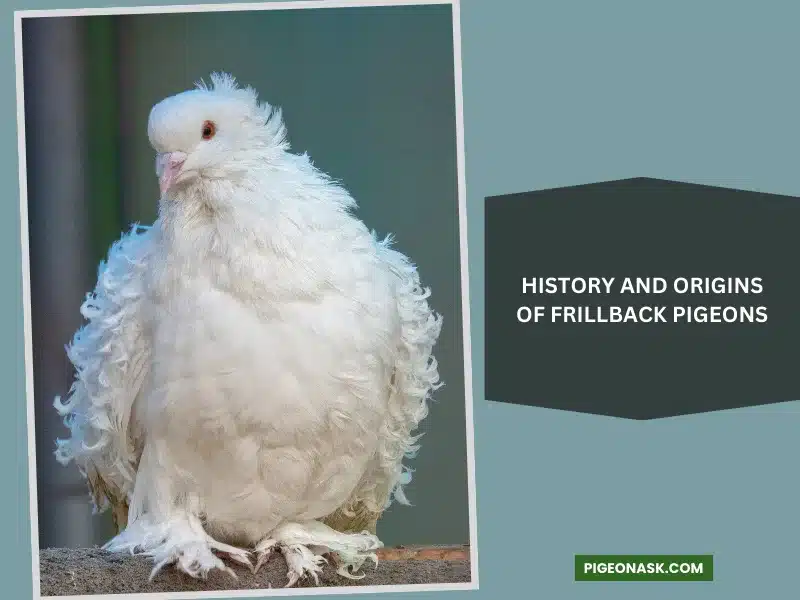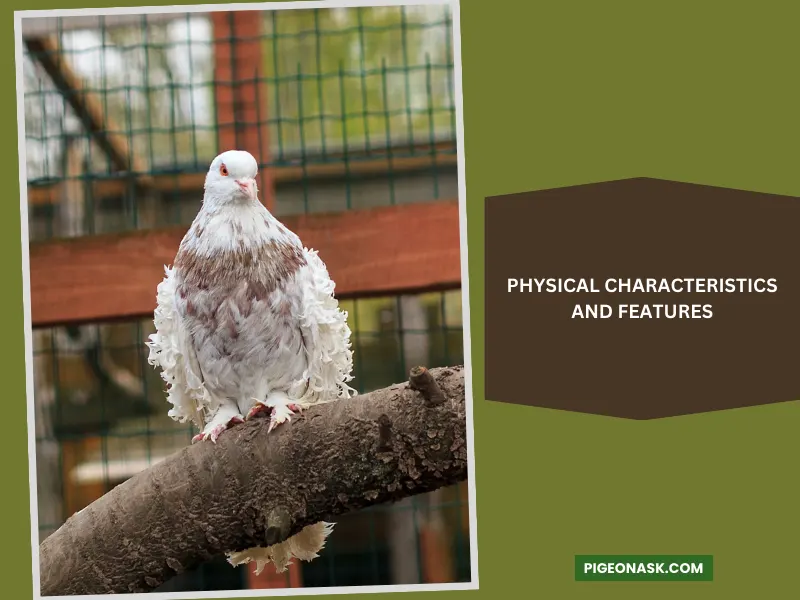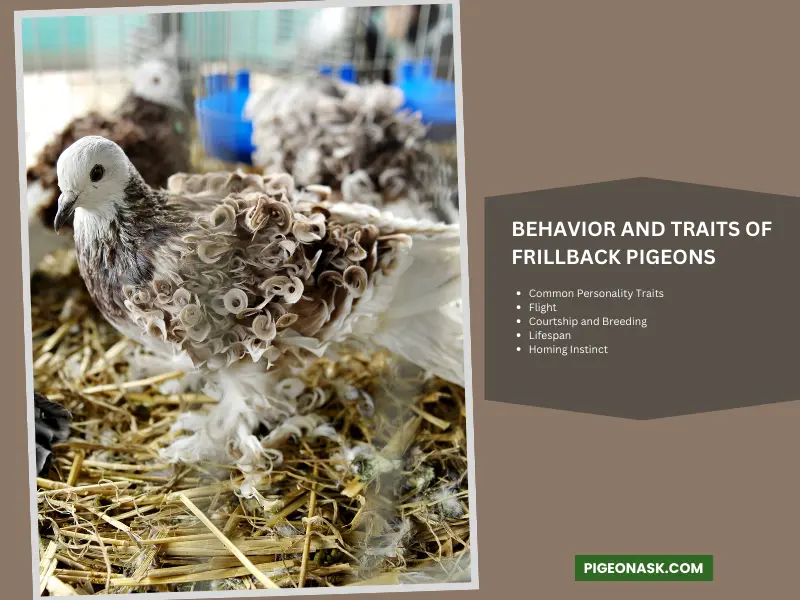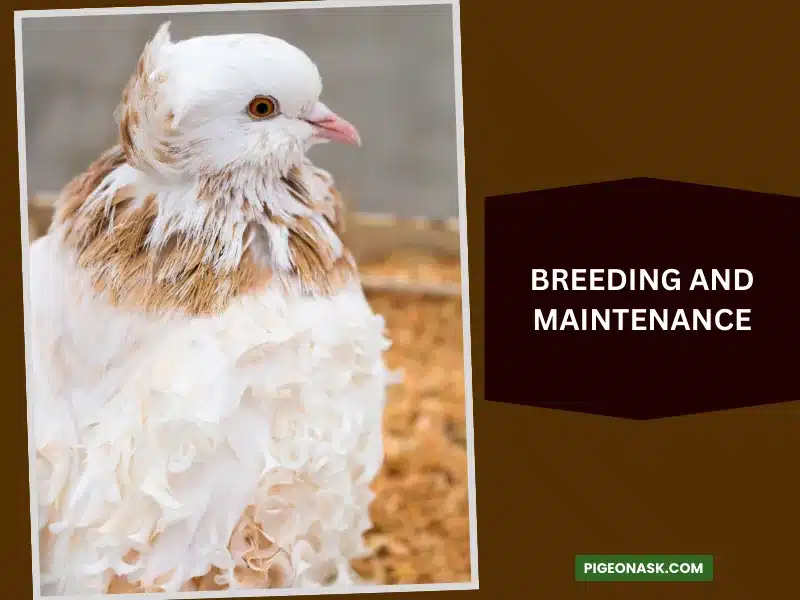Frillback Pigeon: Breed Guide (With Infographic)
Did you know that Charles Darwin allegedly had a Frillback pigeon as a pet? Impressive, isn’t it? The beauty of these pigeons captivated the author of The Origin of Species, it can certainly captivate us to this day still.
After all, the Frillback pigeon is easily the fanciest of all pigeon breeds.
Popular for its curly feathers, the Frillback possesses a variety of features and traits that make it unique. As a result, it’s a bird mostly used for show or ornamental purposes.
Everything about this bird is fascinating, from its characteristic appearance to its unusual and gentle behavior toward humans.
Stick around as we explore this breed of pigeons in deep, discussing their typical looks, how to get a pair, and how to breed them successfully.
Frillback Pigeon Profile
| Name | Frillback Pigeon |
|---|---|
| Scientific Name | Columbia Livia |
| Common Names | Frillback Pigeon |
| Origin | Asian, Iran |
| Size | Medium |
| Weight | 300-450 grams |
| Lifespan | From 5 to 7 years |
| Physical Features | Long and wings tails covered with many fathers, round heads, short beaks, and big and bright eyes |
| Temperament | Gentle |
| Behavior | Docile |
| Special Features | Frill & Muff |
| Breeding and Maintenance | Average, not complicated. |
| Common or Popular Varieties | Self Pattern Grizzle Shield marked ARC & ARCP |
Overview
The Frillback is a breed of pigeon resulting from years of selective breeding. Pigeons classified as Frillback are fancy, primarily used for show and ornamental purposes. However, these birds also make for good pets.
Looking for more articles about pigeons breed:
History and Origins of Frillback Pigeons
The Frillback pigeon is a fascinating bird, but how did it originate? The most popular theory is that Frillback pigeons originated in Asia, in what we currently know as Iran. Then, the pigeon reached Europe in the 16th century.

Like most domesticated fancy pigeons, breeders used selective breeding procedures to develop the breed as they are today.
Nonetheless, it was only until the 1900s that the pigeon allegedly developed into what it is now. Then the pigeons first arrived in the United States in 1911.
How They Were Bred and Developed?
The Frillback is a breed of birds that resulted from the mutation of wild Rock pigeons. Then, breeders employed selective breeding techniques for many years to develop the Frillback as we know it today.
How Did It Develop Its Distinctive Frilled Feathers?
Frillback pigeons have three genes involved in their breeding, which are CU1 and CU2. These genes are responsible for making the feathers grow in an uneven pattern, resulting in the curly-like appearance of their feathers.
Physical Characteristics and Features
Popular for its curly-like feathers, the Frillback pigeon is unlike any other. Let’s talk about its common features to understand this breed a bit more.
Appearance and the Typical Physical Characteristics of a Frillback Pigeon
Frillback pigeons have a beautiful appearance, showing long tails and wings covered with many feathers.

It’s because of their unique appearance that this breed of bird is easily recognizable and sometimes used for marketing campaigns.
The Frillback pigeon has the following typical characteristics:
Head: The head of the pigeon is round and has a crest made of feathers. This crest can vary. Some have feathers spiraling into a pattern, while others are regular.
Beak: Frillback pigeons have short beaks that curve downward slightly. Nonetheless, the beaks are surprisingly resistant, allowing the pigeon to crack hard shells.
Eyes: These pigeons have big and bright eyes, and they can come off as very expressive sometimes. If the bird feels excited or afraid, their eyes would be a giveaway of their emotions.
Unique Features: The most unique features of Frillback pigeons are their muffs and frills. If you don’t know what the muff is, it’s a feature found on the neck of the Frillback.
It has plenty of feathers growing in a curly pattern, similar to the crest on the head of the bird. And then there’s the frill, which is the most distinctive feature of the breed and the reason behind its name.
The frill consists of feathers that grow following a spiral pattern, which adds beauty and a unique trait to these birds.
Some Common Variations in Colors and Markings Across Different Species
The Frillback pigeon can be very diverse, and many have different markings and patterns. For example, birds can have wings featuring bars, checks, and spots.
These visual traits make the pigeons more unique, adding more beauty to their already captivating appearance.
What Color Are Frillback Pigeon Feathers?
The color of Frillback pigeon feathers can be black, yellow, orange, blue, white, brown, or cream. Nonetheless, the most popular combinations are the following –
Self, which is a Frillback of white, black, red, or yellow colors.
Pattern, with features like rosewing and whiteside, paired with a recessive red mottle and yellow mottle.
Grizzle, a variation of red, yellow, blue, or silver.
Shield marked, which consists of red, yellow, a bar (blue-black), an ash-red bar, and an ash-cream bar.
ARC, a classification assigned to Frillbacks with Any Rare Color.
ARCP, used to classify frillback pigeons with Any Rare Color Pattern.
Behavior and Traits of Frillback Pigeons
While most people love Frillback pigeons for their beauty, not many are aware of their unique personalities and traits. Here, we break down the usual behavior of these pigeons so you know what to expect.

Common Personality Traits
One of the most interesting personality traits of a Frillback pigeon is that it can be pretty smart. Over time, the bird will recognize your voice and follow some commands with proper training.
This means you can teach the pigeon new tricks, and their fast-learning abilities will help them adapt to most situations quickly.
The Frillback is a breed of birds with a calm and gentle temperament. This is noticeable when humans raise them from a young age, as the pigeons will allow breeders to grab them if necessary.
So, if someone wants these pigeons as pets, they most likely won’t be any problem.
Flight
Frillback pigeons have a decent flying ability. However, when they fly, they usually fly really close to the ground. Sometimes, it may look like they prefer just walking to their destinations.
This doesn’t mean they won’t escape if you leave them outside. So, it’s better to keep them enclosed to keep them from flying away.
The alternative would be to clip their wings, but the Frillback will lose much of its appeal if this happens.
Courtship and Breeding
During the breeding season, the Frillback male will perform a characteristic mating call to get the female’s attention. Then, mating will occur, and the Frillback female will start developing the eggs.
Once the female is ready, she will produce up to six eggs per clutch. This is when human intervention may be necessary to monitor the eggs and evaluate their conditions.
Lifespan
The lifespan of a Frillback pigeon will depend on the living conditions and overall safety. Therefore, it’s important to create a quality habitat free of diseases and physical defects.
The location of the cage is equally crucial to keep predators away. Under the right conditions, Frillback pigeons can live from five to seven years.
Homing Instinct
Frillback pigeons have decent homing ability, making them decent birds for shows and contests.
Breeding and Maintenance
Now, let’s talk a bit more about the impost important aspects: breeding and maintenance.
Before going into these elements, it’s important to address one thing. Sometimes, the offspring of two white Frillback will not be the same color as the parents.

This happens very rarely, and it can be confusing since most would assume they would be the same color. So, the youngsters resulting from two white-colored pigeons can be of a rare color altogether.
The reason this happens is because of the genes. Realistically, the white gene is a blend of ash red combined with two parts grizzle. As a result, the offspring will retain these traits and grow up to be a brownish bird instead.
There’s a lot of luck involved here, as the ultimate color of the offspring is not predictable.
Information About Raising and Breeding
Due to their interesting look, it may seem like this pigeon breed requires a lot of special attention during breeding. However, this procedure is easier than most people would think.
How Do You Breed Frillback Pigeons?
The breeding initiation often takes time, and it can be tricky. Nonetheless, this breed prefers reproducing when the days start to get longer.
For this reason, breeders mustn’t have automated floodlights that could interfere with the breeding of the birds.
Then, the process is fairly easy. You don’t have to do anything different than follow the same procedure as with other pigeons.
For example, you will have to identify when the breeding season is coming and make sure the birds are comfortable in their habitat.
Some Tips and Considerations for Successful Breeding
The following are simple tips that can make a huge difference when you try to breed Frillback pigeons with more success.
01. Choose healthy birds for breeding: Look for reputable sellers, and discard birds with physical defects to ensure the quality of their offspring.
02. Treat the birds gently: Frillback pigeons are docile, but they can be vulnerable if you don’t handle them safely. If you need to grab them, do it gently to prevent injuries.
03. Separate breeding pairs: During the breeding season, the males can be aggressive or territorial. Assign another area for the male and female during this time to avoid fights.
04. Keep track of every pigeon to avoid inbreeding: Otherwise, the risk of having younglings with physical defects will be higher.
05. Clean the cage or aviary regularly: Avoid building up droppings or waste that could jeopardize the health of the pigeons.
06. Monitor the eggs: Evaluate the eggs produced, and check if all of them are clear of fertilization problems. If you find an unfertilized egg, remove it.
07. Separate the mating pairs: After breeding, consider separating males and females. Don’t try again so soon, and wait for at least a couple of months before attempting to breed them again. Ideally, each pair should have three or fewer cluthes per year.
08. If the color of the pigeon is very dark, assign a safe open space for the bird, preferably with shade: If they get exposed to strong sunlight for too long, the feathers will lose quality and less colorful.
Feeding and Housing Requirements
Frillback pigeons need a balanced diet, so you will definitely need to get some seeds, fruits, vegetables, and grains as supplies.
You must create a proper mix of these ingredients and feed the birds regularly throughout the day.
Similarly, you must provide clean water, preferably in a shallow pan. This item will allow the birds to remain hydrated with fewer risks of creating a mess on the floor.
Housing Requirements
If you want to raise Frillback pigeons, you better be ready to make the most comfortable living conditions for them. Ideally, these birds require a spacious 2x2x4 feet cage to move around freely.
Also, the cage should be resistant, like made with stainless steel.
This cage must remain in a comfortable area with proper ventilation. Avoid any location with direct sunlight or heavy winds, as these will disturb the pigeons.
The bedding should be easy to clean and absorbent, as it will be easier to maintain.
Lastly, you must introduce nesting materials like straws or twigs, which the birds will use to build their nests. Perches set at different heights will also help.
Frequently Asked Questions
Are Frillback pigeons good for showing?
Yes, Frillback pigeons are good for showing, and that is the primary reason why breeders raise them. The quality of their feathers, unique frill, and captivating body shape make the Frillback an ideal decorative or ornamental bird.
How much does a Frillback pigeon cost?
A pet quality Frillback pigeon is around $10 to $30, whereas the higher quality birds for show purposes start at $50 and can be as expensive as $200 or more. The overall price will depend on several factors, like the quality of the bird and its availability in your region.
Do Frillback Pigeons Make Good Pets?
Frillback pigeons make good pets if they get used to being around humans early in their lives. Sudden exposure to new people or owners may cause them to feel stressed, which can make the birds lose their feathers, suffer decreased health, or experience panic attacks.
For this reason, you should raise the pigeons yourself if you want to keep them as pets. Plus, you can make them feel even more comfortable by keeping them in pairs or groups.
Final Word
The Frillback pigeon is a fascinating bird with an intriguing origin story. While most would prefer these birds for their fancy appearance, they also make great pets you want to keep around if you’re a bird enthusiast.
The Frillback is not only beautiful but also a highly intelligent creature that could be a great home pet.
Found this article interesting? Then don’t forget to catch up with us on Facebook, Twitter, and Pinterest for more interesting facts and details about the bird world!
Image Credit:
- Canva.com/photos
